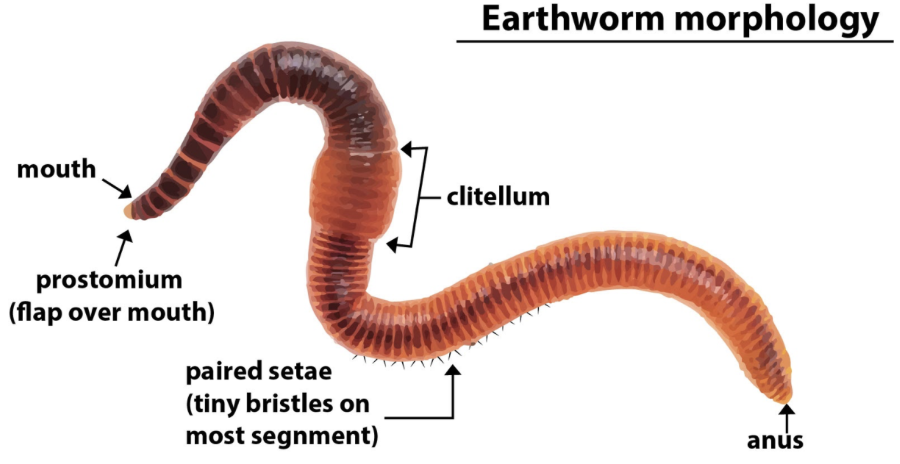
Earthworm respires by -
(a) Clitellum
(b) Ctenidia
(c) Moist skin
(d) Typhlosole
Answer
480.6k+ views
Hint: Earthworms live in moist soils as it is necessary for their movement and other processes. It is also observed that earthworms die in dry weather as they need to be surrounded by moisture and humidity for an important process for survival.
Complete answer:
- Earthworms do not have lungs and they breathe through their skin.
- The respiration occurs by the diffusion of gases through the skin. For this to occur, the skin has to remain moist. The earthworm produces body fluids and mucus to maintain the skin moisture and it also has to live in damp or moist soil.

- Earthworms also have light-sensitive tissue on their head that detects whether it is daytime so they do not arise from the soil as the chance of the moisture getting evaporated is high.
- Both oxygen and carbon dioxide pass through the skin. The gas dissolves in the blood plasma and is oxygenated by the circulatory system. Obtaining oxygen from the soil requires the movement of the earthworm.
Additional Information:
- Clitellum is a non-segmented and glandular part in earthworms that is required for the storage of eggs.
- Ctenidia (or singular Ctenidium) are respiratory organs or gills present in molluscs.
- Typhlosole is an intestinal organ in earthworms that digests food and increases the surface area of the intestines.
- Water and salts also pass through the skin through active transport.
So, the correct answer is ‘(c) Moist skin’.
Note:
- If the skin of the earthworm dries out, the earthworm suffocates due to lack of oxygen.
- Earthworms appear on the surfaces during the rainy season as the soils they inhabit become waterlogged and block the diffusion of gases.
Complete answer:
- Earthworms do not have lungs and they breathe through their skin.
- The respiration occurs by the diffusion of gases through the skin. For this to occur, the skin has to remain moist. The earthworm produces body fluids and mucus to maintain the skin moisture and it also has to live in damp or moist soil.

- Earthworms also have light-sensitive tissue on their head that detects whether it is daytime so they do not arise from the soil as the chance of the moisture getting evaporated is high.
- Both oxygen and carbon dioxide pass through the skin. The gas dissolves in the blood plasma and is oxygenated by the circulatory system. Obtaining oxygen from the soil requires the movement of the earthworm.
Additional Information:
- Clitellum is a non-segmented and glandular part in earthworms that is required for the storage of eggs.
- Ctenidia (or singular Ctenidium) are respiratory organs or gills present in molluscs.
- Typhlosole is an intestinal organ in earthworms that digests food and increases the surface area of the intestines.
- Water and salts also pass through the skin through active transport.
So, the correct answer is ‘(c) Moist skin’.
Note:
- If the skin of the earthworm dries out, the earthworm suffocates due to lack of oxygen.
- Earthworms appear on the surfaces during the rainy season as the soils they inhabit become waterlogged and block the diffusion of gases.
Recently Updated Pages
Master Class 11 Economics: Engaging Questions & Answers for Success

Master Class 11 Business Studies: Engaging Questions & Answers for Success

Master Class 11 Accountancy: Engaging Questions & Answers for Success

Master Class 11 English: Engaging Questions & Answers for Success

Master Class 11 Computer Science: Engaging Questions & Answers for Success

Master Class 11 Maths: Engaging Questions & Answers for Success

Trending doubts
State and prove Bernoullis theorem class 11 physics CBSE

What are Quantum numbers Explain the quantum number class 11 chemistry CBSE

Write the differences between monocot plants and dicot class 11 biology CBSE

Why is steel more elastic than rubber class 11 physics CBSE

Explain why a There is no atmosphere on the moon b class 11 physics CBSE

1 ton equals to A 100 kg B 1000 kg C 10 kg D 10000 class 11 physics CBSE




